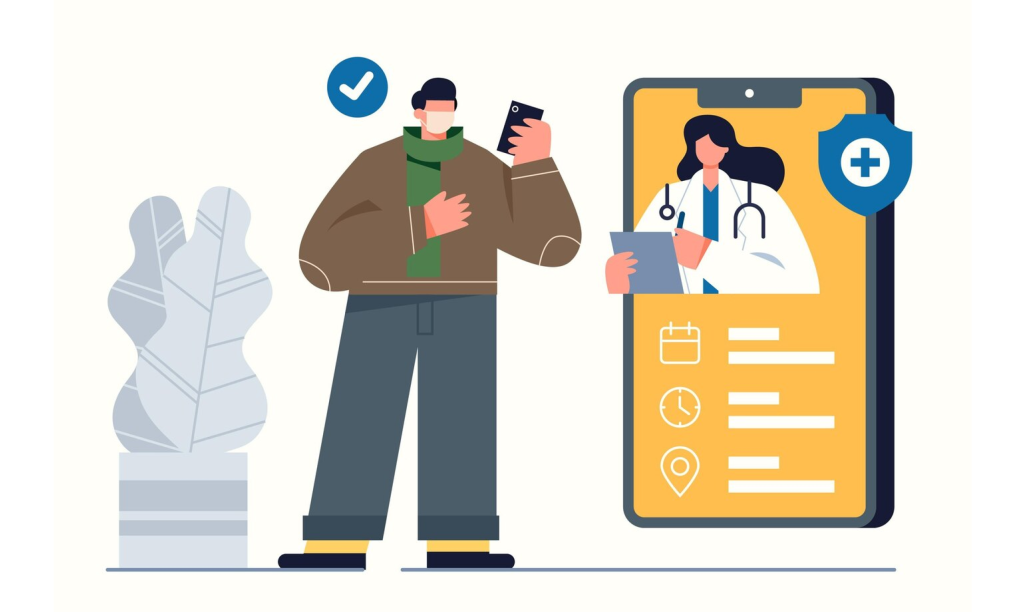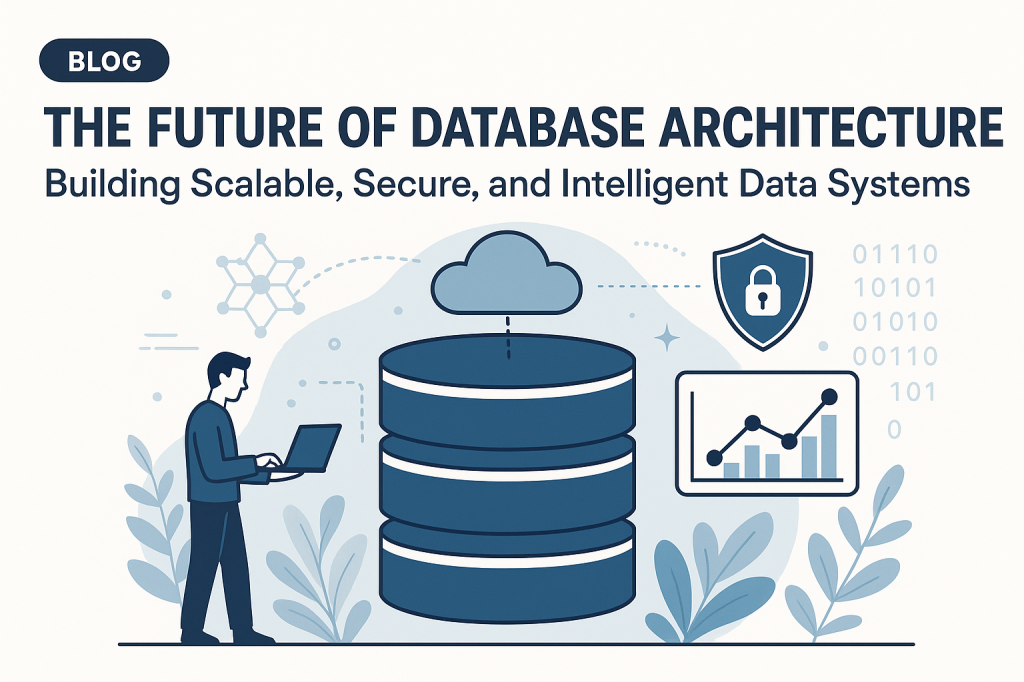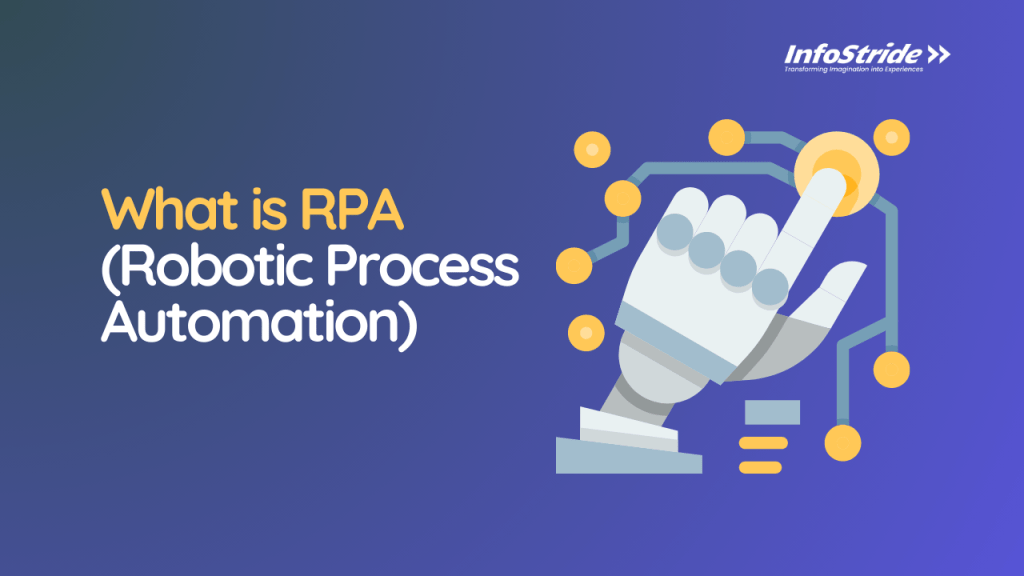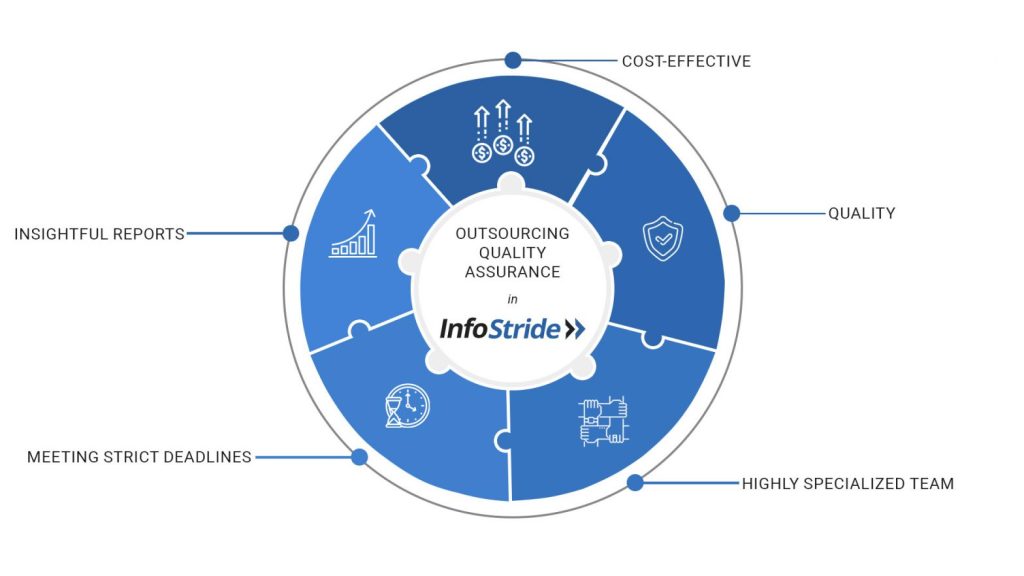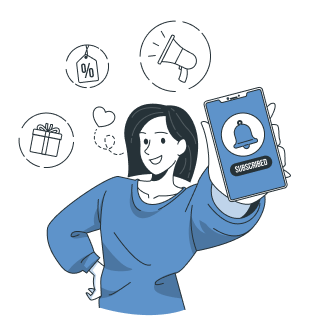In recent years, the healthcare industry has experienced a transformative wave propelled by the rapid integration of mobile applications. The phrase “Develop a healthcare app” has become a rallying cry for innovation in healthcare delivery. The surge in the use of mobile apps within the healthcare sector is nothing short of remarkable, with statistics reflecting an unprecedented boom. According to recent industry reports, the global healthcare app market is projected to reach a staggering $105.09 billion by 2030, underlining the immense potential and growing significance of mobile applications in reshaping the healthcare landscape.
Several factors have contributed to the surge in healthcare app development in 2024. The widespread adoption of smartphones, coupled with advancements in technology, has empowered both healthcare providers and patients with convenient tools for monitoring, diagnosis, and treatment.
Let’s embark on a journey through the dynamic realm of healthcare app development in 2024. From compliance to cutting-edge technologies, we unravel the key facets that define the landscape and explore how this digital evolution is poised to redefine the healthcare experience for all stakeholders.
What is a Healthcare app?
A healthcare app is a specialized software designed to address various aspects of healthcare delivery, promoting better patient engagement, streamlined communication, and improved health outcomes. These applications cater to a diverse range of users, including both healthcare professionals and patients. Healthcare apps can encompass a wide array of functionalities, from basic health monitoring and medication management to sophisticated telemedicine platforms.
Patients use healthcare apps for various purposes, such as tracking their vital signs, managing chronic conditions, and receiving personalized health information. Additionally, these apps facilitate appointment scheduling, prescription refills, and real-time communication with healthcare providers. On the other hand, healthcare professionals leverage apps to access patient records, monitor treatment plans, and even conduct remote consultations through telehealth features.
Types of Healthcare Apps:
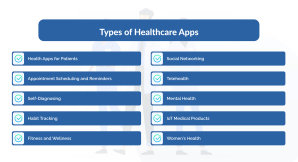
A diverse array of applications plays pivotal roles in shaping patient care, provider workflows, and administrative processes. Categorized into three distinct domains—apps for patients, providers, and medical administration staff—these healthcare applications collectively foster a more interconnected, efficient, and patient-centric healthcare ecosystem. From empowering individuals in managing their well-being to optimizing the operational efficiency of healthcare facilities, these types of healthcare apps are at the forefront of transforming and enhancing the healthcare experience for all stakeholders.
1. Health Apps for Patients:
In the era of personalized healthcare, the rise of patient-centric applications has revolutionized how individuals engage with and manage their well-being. From appointment scheduling to mental health support, these apps empower patients with tools to actively participate in their healthcare journey, fostering a sense of control and accessibility.
-
Appointment Scheduling and Reminders:
Patients today benefit from the convenience of healthcare at their fingertips. Appointment scheduling and reminder apps empower individuals to easily manage their healthcare appointments, reducing no-shows and ensuring timely access to medical care.
Example: “Zocdoc” streamlines appointment scheduling, allowing users to find and book appointments with healthcare providers based on location, specialties, and availability.
-
Self-Diagnosing:
While caution is advised, self-diagnosing apps offer users preliminary information about symptoms and potential conditions. These apps can aid individuals in understanding their health concerns, although they are not substitutes for professional medical advice.
Example: “Ada” is a symptom-checker app that helps users assess their symptoms and provides information for informed discussions with healthcare professionals.
-
Habit Tracking:
Promoting healthier lifestyles, habit-tracking apps assist users in monitoring and cultivating positive habits. From tracking water intake to exercise routines, these apps encourage users to take an active role in their overall well-being.
Example: “HabitBull” is a habit-tracking app that allows users to set goals, track progress, and receive motivational reminders to establish and maintain healthy habits.
-
Fitness and Wellness:
Fitness and wellness apps offer personalized exercise routines, nutrition plans, and overall well-being tips. These apps cater to users looking to maintain or improve their physical health through guided workouts and lifestyle recommendations.
Example: “MyFitnessPal” is a comprehensive fitness app that tracks exercise, nutrition, and offers a community for users to share tips and motivation.
-
Social Networking:
Social networking platforms within the healthcare sphere connect individuals with similar health goals. These communities provide a supportive environment where users can share experiences, seek advice, and motivate each other on their health journeys.
Example: “PatientsLikeMe” is a social networking platform that allows users to connect with others who share similar health conditions, fostering a sense of community and understanding.
-
Telehealth:
Telehealth apps revolutionize healthcare accessibility by offering virtual consultations with healthcare professionals. This category of apps provides a convenient and efficient way for patients to receive medical advice without the need for in-person visits.
Example: “Amwell” is a telehealth app that connects users with licensed healthcare providers for virtual consultations, making healthcare accessible from anywhere.
-
Mental Health:
Addressing emotional well-being, mental health apps offer tools for meditation, stress management, and mental health tracking. These apps aim to support users in maintaining a healthy balance between physical and mental health.
Example: “Headspace” is a popular mental health app that provides guided meditations and mindfulness exercises to reduce stress and improve mental well-being.
-
IoT Medical Products:
Integrated with the Internet of Things (IoT), medical products connect to devices for real-time health monitoring. These apps bridge the gap between healthcare providers and patients, offering continuous data for better-informed healthcare decisions.
Example: “Apple Health” integrates with various IoT devices to track and centralize health data, providing a comprehensive overview for both patients and healthcare professionals.
-
Women’s Health:
Specifically tailored to women’s health needs, these apps provide information, tracking tools, and support for various aspects such as menstrual cycles, pregnancy, and reproductive health.
Example: “Clue” is a women’s health app that helps users track menstrual cycles, ovulation, and other relevant health information.
2. Health Apps for Providers:
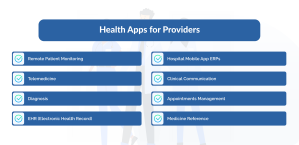
In the fast-evolving landscape of healthcare delivery, providers harness specialized applications to enhance patient care, improve diagnostics, and streamline communication. From remote patient monitoring to diagnostic support, these apps serve as invaluable tools, enabling healthcare professionals to deliver more efficient and effective healthcare services.
-
Remote Patient Monitoring:
Healthcare providers leverage remote patient monitoring apps to keep track of patients’ health outside of traditional healthcare settings. These apps enable continuous monitoring of vital signs, allowing for proactive intervention and personalized care.
Example: “Biofourmis” is a remote patient monitoring platform that uses biosensors to track patients’ physiological data, providing real-time insights to healthcare providers.
-
Telemedicine:
Breaking down geographical barriers, telemedicine apps facilitate virtual consultations between healthcare professionals and patients. These apps improve access to medical care, particularly in remote or underserved areas.
Example: “Teladoc” is a telemedicine platform connecting patients with licensed healthcare providers for on-demand virtual consultations.
-
Diagnosis:
Diagnosis apps assist healthcare professionals in interpreting medical images, diagnostic tests, and clinical data. These tools provide support for accurate and timely diagnosis, enhancing the efficiency of healthcare delivery.
Example: “VisualDx” is a diagnostic clinical decision support system that aids healthcare professionals in identifying and diagnosing various medical conditions.
-
EHR (Electronic Health Record):
EHR apps digitize and centralize patient records, offering a comprehensive and secure platform for healthcare professionals to access and manage patient information. These apps enhance communication and coordination among healthcare teams.
Example: “Epic Systems” provides EHR solutions that integrate patient records, making them accessible to authorized healthcare providers for efficient and coordinated care.
-
Medicine Reference:
Medicine reference apps serve as quick references for healthcare professionals, providing information on drug interactions, dosage, and other relevant details. These tools assist in making informed decisions about patient treatment.
Example: “Medscape” is a comprehensive medicine reference app offering drug information, medical news, and clinical reference tools for healthcare professionals.
-
Hospital Mobile App ERPs:
Hospital mobile app ERPs (Enterprise Resource Planning) centralize and streamline hospital operations. These apps integrate various functions, including scheduling, billing, and inventory management, optimizing overall efficiency.
Example: “Cerner” offers hospital mobile app ERPs that integrate and manage various aspects of healthcare administration, enhancing organizational workflows.
-
Clinical Communication:
Clinical communication apps facilitate seamless communication and collaboration among healthcare teams. These apps ensure timely and secure information exchange, improving patient care coordination.
Example: “TigerText” is a clinical communication and collaboration platform designed to enhance communication among healthcare professionals through secure messaging.
-
Appointments Management:
Optimizing scheduling processes, appointments management apps assist healthcare providers in efficiently organizing and managing patient appointments. These tools reduce administrative burdens and enhance overall clinic efficiency.
Example: “DrChrono” is an appointments management app that offers features like online scheduling, reminders, and check-ins for healthcare providers.
3. Health Apps for Medical Administration Staff:
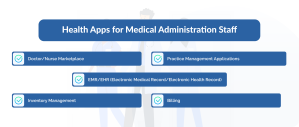
Behind the scenes, medical administration staff relies on a suite of applications to optimize the operational aspects of healthcare facilities. From managing staffing needs to efficiently handling inventory and billing, these apps contribute to the seamless functioning of healthcare administration, ensuring that resources are allocated effectively and processes are streamlined.
-
Doctor/Nurse Marketplace:
Doctor/nurse marketplace apps connect healthcare facilities with qualified professionals, streamlining the staffing process. These apps offer a platform for healthcare administration staff to find and hire medical professionals based on specific needs and qualifications.
Example: “Nomad Health” serves as a doctor/nurse marketplace, connecting healthcare facilities with healthcare professionals for temporary or permanent positions.
-
EMR/EHR (Electronic Medical Record/Electronic Health Record):
EMR/EHR apps digitize and manage patient records efficiently, providing a centralized platform for medical administration staff to organize and access patient information. These apps enhance data accuracy and streamline administrative tasks.
Example: “Cerner PowerChart” is an EMR/EHR solution that supports medical administration staff in managing patient records and administrative tasks.
-
Inventory Management:
Inventory management apps assist medical administration staff in tracking and managing medical supplies efficiently. These apps help ensure that healthcare facilities have the necessary equipment and medications on hand, reducing the risk of shortages.
Example: “Hybrent” is an inventory management app designed for healthcare facilities to streamline procurement, reduce costs, and optimize inventory levels.
-
Billing:
Billing apps automate financial transactions and billing processes, reducing administrative burdens for medical administration staff. These apps help streamline the revenue cycle, improving accuracy and efficiency in financial transactions.
Example: “Kareo” is a billing app that simplifies medical billing processes for healthcare providers, helping medical administration staff manage financial transactions.
-
Practice Management Applications:
Practice management apps optimize the overall functioning of medical practices, supporting medical administration staff in various operational tasks. These apps may include features for scheduling, communication, and overall practice efficiency.
Example: “CareCloud” is a practice management application that integrates various functions, including scheduling, billing, and reporting, to streamline the operations of medical practices.
Also Read – Healthcare Business Ideas
Step to Develop a Healthcare App:
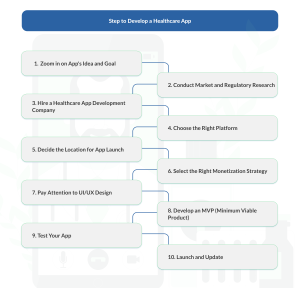
Embarking on the journey to develop a healthcare app requires careful planning, strategic decision-making, and a comprehensive understanding of the dynamic healthcare landscape. From conceptualization to execution, each step is crucial in ensuring the success and effectiveness of the app. In this section, we outline a series of key steps that provide a roadmap for navigating the intricacies of healthcare app development. Whether you’re a healthcare professional looking to enhance patient care or an entrepreneur venturing into the digital health space, these steps serve as a valuable guide to bring your healthcare app vision to fruition.
1. Zoom in on App’s Idea and Goal:
Before delving into development, clarity on the app’s purpose and objectives is paramount. Define the specific healthcare challenges your app aims to address and establish clear goals. Whether it’s improving patient communication, streamlining administrative tasks, or enhancing diagnostic capabilities, a well-defined concept sets the foundation for a successful healthcare app.
2. Conduct Market and Regulatory Research:
Thorough research is essential to understand the existing market landscape and navigate the intricate web of healthcare regulations. Identify competitors, assess market demands, and stay abreast of regulatory requirements to ensure compliance. This research lays the groundwork for a strategic and informed approach to app development.
3. Hire a Healthcare App Development Company:
Collaborating with a reputable healthcare app development company is instrumental in bringing your vision to life. Choose a team with expertise in healthcare app development services, ensuring they understand the nuances of the industry, compliance standards, and the unique challenges associated with healthcare technology.
4. Choose the Right Platform:
Selecting the right platform is a pivotal decision that influences your app’s reach and accessibility. Consider whether your app will be native to iOS, Android, or both. The platform choice should align with your target audience and market penetration strategy.
5. Decide the Location for App Launch:
Determine the geographical locations where you plan to launch your healthcare app. Consider regional healthcare policies, user demographics, and market demand to tailor your app’s features and functionalities accordingly.
6. Select the Right Monetization Strategy:
Define how your healthcare app will generate revenue. Whether it’s through subscription models, in-app purchases, or partnerships with healthcare providers, selecting the right monetization strategy is crucial for the app’s sustainability and growth.
7. Pay Attention to UI/UX Design:
User experience is paramount in healthcare apps. Prioritize an intuitive and user-friendly interface to enhance patient and provider engagement. Thoughtful UI/UX design contributes to better adoption rates and overall satisfaction with the app.
8. Develop an MVP (Minimum Viable Product):
Start with a Minimum Viable Product (MVP) to test your app’s core features and gather user feedback. This iterative approach allows for adjustments based on real-world user experiences, ensuring the final product aligns with user expectations and needs.
9. Test Your App:
Conduct thorough testing to identify and rectify potential bugs, security vulnerabilities, and usability issues. Rigorous testing, including usability testing, performance testing, and security testing, is essential to ensure the reliability and safety of your healthcare app.
10. Launch and Update:
Once testing is complete and feedback has been incorporated, launch your healthcare app. A successful launch is just the beginning; continuously monitor user feedback, address emerging challenges, and implement updates to enhance features and security over time. Regular updates ensure your healthcare app remains relevant and aligned with evolving industry standards.
Emerging Technologies Reshaping Healthcare App Development:
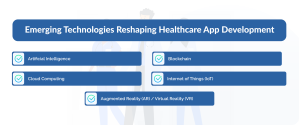
As the healthcare industry undergoes a digital transformation, the integration of cutting-edge technologies into healthcare app development is revolutionizing the way we approach patient care, data management, and overall healthcare delivery. This section explores the forefront of innovation, highlighting the profound impact of emerging technologies on the evolution of healthcare applications. From enhancing diagnostic capabilities to ensuring secure data management, these technologies are pivotal in shaping the future of healthcare app development services.
1. Artificial Intelligence:
Artificial Intelligence (AI) has emerged as a transformative force in healthcare, offering capabilities such as predictive analytics, personalized treatment plans, and efficient data analysis. AI-powered healthcare apps leverage machine learning algorithms to interpret complex medical data, leading to improved diagnostics and treatment outcomes. Notably, AI enables predictive modeling for disease prevention, aiding healthcare professionals in proactive patient care.
2. Cloud Computing:
Cloud computing has become an integral component of healthcare app development, providing scalable storage, seamless data access, and enhanced collaboration among healthcare professionals. According to a recent study, over 83% of healthcare organizations utilize cloud services. Cloud-based healthcare apps facilitate real-time data sharing, enabling secure and efficient collaboration while ensuring accessibility from various devices and locations.
3. Augmented Reality (AR) / Virtual Reality (VR):
AR and VR technologies are redefining medical training, patient education, and therapeutic interventions. Notably, VR is increasingly utilized for virtual surgeries and medical simulations, enhancing training programs for healthcare professionals. In patient care, AR enhances visualization during surgeries, while VR is used for pain management and mental health interventions.
4. Blockchain:
Blockchain technology is revolutionizing healthcare app development by providing a secure and transparent framework for data management. With the ability to ensure the integrity and confidentiality of medical records, blockchain enhances interoperability and facilitates secure data sharing among healthcare providers. Notably, blockchain’s decentralized nature strengthens data security and patient privacy, addressing critical concerns in the healthcare sector.
Also Read: Healthcare App Development Cost
5. Internet of Things (IoT):
The Internet of Things (IoT) is at the forefront of healthcare app development, connecting devices and enabling real-time monitoring of patient health. IoT-enabled healthcare apps facilitate remote patient monitoring, medication adherence tracking, and preventive care. A notable statistic reveals that the global IoT in healthcare market is projected to reach $534.3 billion by 2025, underscoring the significant role of IoT in reshaping healthcare delivery.
These emerging technologies collectively represent the vanguard of innovation in healthcare app development. As we navigate the convergence of technology and healthcare, the integration of AI, cloud computing, AR/VR, blockchain, and IoT promises to redefine standards of patient care, data security, and overall healthcare efficacy.
Best Practices to Develop a Healthcare App:
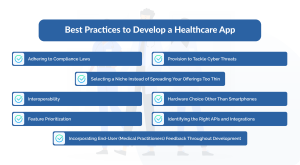
Creating a healthcare app demands a meticulous approach to ensure not only user satisfaction but also compliance with stringent regulatory standards. In this section, we’ll dive into the best practices that should be embraced during the development process to guarantee the success and reliability of healthcare applications. From navigating compliance laws to prioritizing features and ensuring robust cybersecurity measures, these practices serve as a guide for developing healthcare apps that stand at the intersection of innovation and regulatory adherence.
1. Adhering to Compliance Laws:
Developers must navigate a complex web of compliance laws to ensure the security and privacy of patient data. Adhering to standards such as Health Insurance Portability and Accountability Act (HIPAA), California Consumer Privacy Act (CCPA), General Data Protection Regulation (GDPR), National Institute of Standards and Technology (NIST), Health Information Technology for Economic and Clinical Health Act (HiTECH), and Personal Information Protection and Electronic Documents Act (PIPEDA) is crucial. Each regulation serves a unique purpose, ensuring the confidentiality, integrity, and availability of healthcare information.
- HIPAA (Health Insurance Portability and Accountability Act): Ensures the protection of patient health information (PHI) and establishes guidelines for healthcare app developers to safeguard sensitive data.
- CCPA (California Consumer Privacy Act): Focuses on consumer data protection, granting California residents greater control over their personal information.
- GDPR (General Data Protection Regulation): Applies to healthcare apps operating in the European Union, emphasizing the protection of individuals’ privacy and the lawful processing of personal data.
- NIST (National Institute of Standards and Technology): Provides a framework for securing information systems, essential for maintaining data integrity and confidentiality.
- HiTECH (Health Information Technology for Economic and Clinical Health Act): Extends HIPAA requirements to electronic health records (EHR) and promotes the adoption of health information technology for improved patient care.
- PIPEDA (Personal Information Protection and Electronic Documents Act): Governs the collection, use, and disclosure of personal information in the private sector, essential for healthcare apps operating in Canada.
2. Selecting a Niche Instead of Spreading Your Offerings Too Thin:
Focusing on a specific niche within healthcare allows developers to tailor features to meet the unique needs of that segment. Whether it’s mental health, chronic disease management, or telehealth, specializing in a niche enhances the app’s effectiveness and relevance, fostering a more targeted and engaged user base.
Also Visit: Custom Software Development Services
3. Interoperability:
Ensuring interoperability with existing healthcare systems and devices is critical for seamless data exchange and collaborative patient care. Embracing standardized protocols and formats facilitates integration with Electronic Health Records (EHR), diagnostic equipment, and other healthcare technologies.
4. Feature Prioritization:
Identifying and prioritizing essential features is fundamental for the success of a healthcare app. Common and vital features include appointment scheduling, secure messaging, medication tracking, and telehealth capabilities. Prioritizing features ensures that the app addresses core healthcare needs while maintaining a user-friendly interface.
5. Provision to Tackle Cyber Threats:
Cybersecurity is a top priority in healthcare app development. Implementing robust measures such as encryption, secure authentication, and regular security audits is imperative to protect sensitive patient data from cyber threats and unauthorized access.
6. Hardware Choice Other Than Smartphones:
Consideration should be given to extending app accessibility beyond smartphones. Developing versions for smartwatches or a desktop/web interface ensures a broader reach and accommodates diverse user preferences and needs.
7. Identifying the Right APIs and Integrations:
Selecting compatible Application Programming Interfaces (APIs) and integrations enhances the functionality of healthcare apps. Integrating with health databases, wearable devices, and third-party services can provide valuable data insights and improve overall user experience.
8. Incorporating End-User (Medical Practitioners) Feedback Throughout Development:
Engaging medical practitioners in the development process ensures that the app meets the practical needs of healthcare professionals. Continuous feedback from end-users helps refine features, optimize workflows, and enhance the overall usability and effectiveness of the healthcare app.
How InfoStride Can Help in Developing a Healthcare App:
Choosing InfoStride as your healthcare app development partner brings a wealth of benefits derived from our deep industry expertise and extensive experience in the healthcare domain. Our seasoned professionals navigate the intricacies of healthcare app development with a profound understanding of regulatory compliance, data security, and industry-specific challenges. From ideation to execution, InfoStride excels in custom health app development that align seamlessly with client objectives.
For startups seeking to validate their healthcare app concepts efficiently, our MVP development services offer a cost-effective approach to test market viability. We specialize in crafting custom healthcare apps tailored to unique client requirements, whether it’s telehealth applications, patient management systems, or innovative diagnostic tools. With a focus on healthcare mobile app development, we ensure accessibility, ease of use, and seamless integration, shaping the future of digital healthcare with a commitment to excellence from MVP to full-scale development.
Frequently Asked Questions
1- What is the Future of Healthcare Apps?
The future of healthcare apps is marked by continued innovation and integration of advanced technologies in healthcare mobile app development. Predictive analytics, artificial intelligence, and enhanced interoperability will play pivotal roles, providing personalized healthcare experiences. Telehealth and remote patient monitoring will become more prevalent, expanding access to medical care. The focus will shift towards preventive health, with apps promoting holistic well-being and proactive disease management. Ultimately, healthcare apps will form an integral part of a patient-centric, digitally-driven healthcare ecosystem, showcasing the potential for ongoing healthcare app development services.
2- Why Do Health Apps Fail?
Health apps may fail due to various reasons, including inadequate market research, lack of user engagement, and poor user experience in custom health app development. Insufficient compliance with healthcare regulations can also lead to failure. Security concerns, such as data breaches, can erode user trust. Additionally, failure to address the specific needs of the target audience, lack of interoperability, and an oversaturation of features can contribute to app failure. Successful health apps require a strategic approach that considers user needs, industry regulations, and ongoing innovation, highlighting the importance of MVP Development Services for Startups.
3- What Are the Challenges of mHealth Apps?
mHealth apps face challenges such as ensuring data security and privacy, especially when dealing with sensitive health information. Achieving seamless interoperability with existing healthcare systems is another hurdle. User engagement and adherence pose challenges, as sustaining user interest is crucial for the app’s effectiveness. Addressing diverse healthcare needs and maintaining regulatory compliance further complicate mHealth app development. Overcoming these challenges requires a comprehensive understanding of the healthcare landscape and a user-centric approach, emphasizing the importance of specialized healthcare app development services.
4- Who is the Target Audience of Health Apps?
The target audience for health apps is diverse and includes both healthcare providers and consumers. Patients use health apps for managing chronic conditions, monitoring vital signs, and accessing telehealth services. Healthcare professionals utilize apps for efficient patient care, remote monitoring, and accessing medical references. Employers may also be a target audience for corporate wellness apps. Overall, the target audience varies based on the app’s purpose, ranging from individuals seeking personalized health solutions to healthcare professionals optimizing their workflows. The broad appeal underscores the need for versatile healthcare app development strategies.
